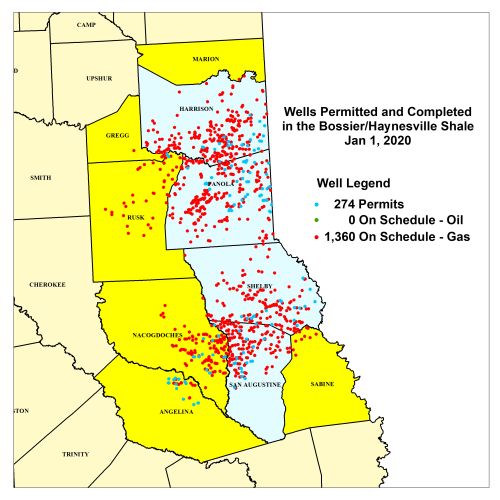Haynesville/Bossier Shale
Information & Statistics
What is the Haynesville/Bossier Shale?
The Haynesville/Bossier Shale, located in East Texas (Railroad Commission of Texas District 6) and Western Louisiana, is a hydrocarbon-producing geological formation capable of producing large amounts of gas. The productive interval of the shale is greater than 10,000 feet below the land surface. There has been some confusion in whether the formation is the Haynesville Shale and/or the Bossier Shale because of different geological naming conventions in Texas and Louisiana. It is generally recognized that the shale interval in East Texas is the Lower Bossier that correlates with the Haynesville of Louisiana. The Upper Bossier Formation is distinguished from the Lower Bossier Formation by its location, to the southwest, and the fact that it is more sand-rich.
Most operators designated the field for wells drilled in the Bossier Shale Formation in Shelby, Panola and Harrison counties as the Carthage, North (Bossier Shale). However, as the area developed, operators assigned wells to the Beckville (Haynesville) and Waskom (Haynesville) Fields. Hence, the names for Haynesville and Bossier Shale are used interchangeably. In December 15, 2009, the Railroad Commission of Texas issued an order consolidating the existing Haynesville/Bossier field discoveries in this area into the Carthage (Haynesville Shale) field. This consolidation means that wells previously reported to these fields now report all completion and production information under the Carthage (Haynesville Shale). The Carthage (Haynesville Shale) field now represents the majority of the Haynesville/Bossier production in these counties.
Production
Disclaimer: This data is a snapshot in time displaying production data from the RRC’s Production Data Query System (PDQ) based on the extract date.
Current Annual Production ![]()
-
Historical Production
- Haynesville Bossier Shale 2020
- Haynesville Bossier Shale 2019
- Haynesville Bossier Shale 2018
- Haynesville Bossier Shale 2017
- Haynesville Bossier Shale 2016
- Haynesville Bossier Shale 2015
- Haynesville Bossier Shale 2014
- Haynesville Bossier Shale 2013
- Haynesville Bossier Shale 2012
- Haynesville Bossier Shale 2011
- Haynesville Bossier Shale 2010
- Haynesville Bossier Shale 2009
- Haynesville Bossier Shale 2008
- Haynesville Bossier Shale 2008 To Current
Top Ten Operators ![]()








